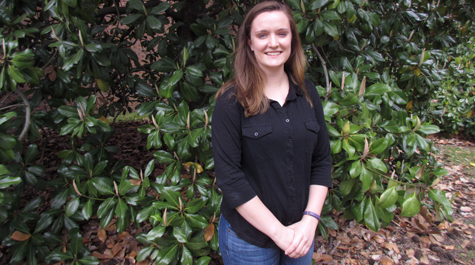Nathalie Moore wins $50,000 GRO Fellowship from US EPA
Nathalie Moore made an early jump into the opportunities for research at William & Mary.
“I was very, very fortunate. I came in during freshman orientation and told my pre-major advisor that I wanted to do research. That was Jon Allen, who is wonderful,” Moore said. “He encouraged me to find something at the Virginia Institute of Marine Science.”
An award from the U.S. Environmental Protection Agency recognizes Moore’s research accomplishments as well as provides opportunities for additional environmental research.
The award is a Greater Research Opportunities (GRO) Fellowship. The GRO Fellowship provides the awardee with funding for two years of college, plus a paid summer internship. Moore, a member of William & Mary’s class of 2017, will receive up to $20,700 in support for each of her two final undergrad years, plus a stipend of $8,600 for the three-month internship.
“The idea is that you wouldn’t have to work during the summer to pay for school,” Moore said.
Moore was selected for her first-choice summer internship. She will work at the EPA’s Atlantic Ecology Division lab at Narragansett, Rhode Island, near Cape Cod. The lab studies the role that coastal wetlands play in mitigating climate changes. Marsh plants have the ability to trap atmospheric CO2, storing the carbon below ground.
There is evidence that excess nitrogen, from human sources such as wastewater discharge and agricultural runoff, has an adverse impact on the beneficial carbon-storage property of wetland plants. Moore says she expects her work to help fill gaps in the understanding of how coastal wetlands react to environmental changes.
“What I believe I will be doing is looking at the effects of anthropogenic pollutants and climate-change stressors on marsh ecosystem dynamics,” Moore said. The lab’s hypothesis indicates that the excess nitrogen stimulates the activity of the marsh plants’ roots, prompting in turn the cycling of carbon back into the environment.
A description of the project from the Atlantic Ecology Division lab suggests Moore might be doing field studies. (“Hip boots, chest waders, and other relevant field gear will be provided,” the synopsis notes.) There also will be opportunities for lab and greenhouse work.
“The intern will learn to use cutting‐edge analytical equipment including a Picarro greenhouse gas analyzer and an Isotope Ratio Mass Spectrometer used to measure carbon and nitrogen concentrations,” the description reads. “They will be trained in wetland plant identification, become an expert in root sorting, and learn to apply a broad range of field sampling methods.”
Moore is the first William & Mary student to be awarded a GRO Fellowship. She will go to Narragansett well prepared, as she has developed lab and field skills several previous research experiences.
Encouraged by Allen, she worked six months as a lab technician at VIMS. Moore credits that freshman-year introduction to the research world with giving her the confidence to take the next step. She applied, and was accepted, into a Research Experience for Undergraduates. REUs are programs supported by the National Science Foundation.
The idea behind an REU is to give college students summer opportunities to conduct scientific study under the guidance of a faculty researcher. REU programs are hosted at U.S. universities and all U.S. college students. Moore joined a REU group conducted by William & Mary Professor of Biology John Swaddle as part of the Reves Center for International Studies’ Faculty Fellows program.
“I went to Australia for a summer of field work,” she said. “There, I was looking at the effects of an invasive grass on changing fire regimes.”
Moore explained that Australians imported a species known as gamba grass in the 1930s. She explained that the grass is native to Africa and was brought to Australia as forage for livestock. It got out of hand pretty quickly.
“It produces three times the biomass of a native grass and it can grow up to four meters taller than native grass,” she said. “I’ve seen it get up to five, five and a half meters.”
Moore said that gamba grass was kept under control in its native habitat by robust foraging and even trampling by large animals. In Australia, stretches of gamba grass, reaching 16 feet and more, brought a couple of problems.
Her group investigated the effects of gamba grass on Australian wildfires and especially on small birds known as fairy wrens. She said the group is writing a paper on their findings and hopes to submit it in the next two weeks.
“That was my big research experience at William & Mary,” she said. “After that I applied to another REU because I wanted to diversify my experience.”
That second REU experience was an internship at the Marine Biological Laboratory at Woods Hole Oceanographic Institute, where she studied the effects of nitrogen loading on small fish at Plum Island estuary in Massachusetts.
Moore is a double major in biology and environmental science. She says she is still considering her post-graduation options.
“I plan to be in grad school,” she said. “But hopefully not too long. I’m not quite sure yet if I want to pursue academia or be a pure research scientist, but I know I’ll need a Ph.D. for whatever I’ll be doing.”
She credits a list of advisers at William & Mary — Keck Lab Director Randy Chambers and Assistant Professor of Biology Matthias Leu, in addition to Allen and Swaddle — for encouraging her.
“I’ve been incredibly lucky to have the advisors that I’ve had. If they hadn’t taken a chance on me, I might not have been lucky enough to receive this honor,” she said. “And I intend to take full advantage of it.”
 Skip to main content
Skip to main content

